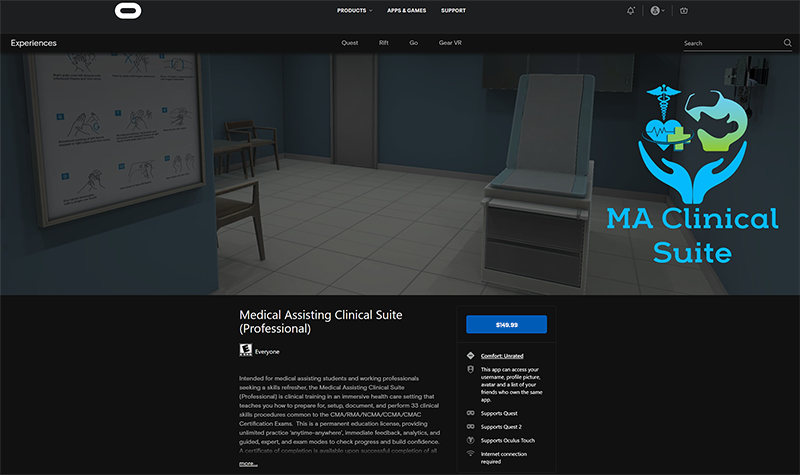Personal protective equipment (PPE) consist of gloves, mask, gown, and goggles/face shield. Gloves reduce the risk of contamination to hands but do not prevent needles or other sharp instruments from penetrating the skin. Masks and protective eyewear reduce the contamination risk to mucous membranes of the eyes, nose, and mouth. Gowns protect clothing from contamination. A medical assistant may be exposed to infected blood and/or body fluids and must wear PPE. This skill lab teaches you how to don and doff PPE.
This lab is based on the entry-level competencies for which the Commission on Accreditation of Allied Health Education Programs (CAAHEP) and Accrediting Bureau of Health Education Schools (ABHES) test the Medical Assistant.
Learning Sequence Builds Confidence
The learner practices the procedure in the ‘guided mode’ (interaction hints and an expanded checklist guide) as often as they like.
When the learner is confident that they can accurately demonstrate the procedure without error, the learner plays the level in the ‘expert mode’ (no hints or checklist explanations) - which they can repeat as often as they wish.
Finally, when the learner is confident that they have mastered the procedure - they take a one-time ‘exam’ attempt which results in their grade for that procedure.
The Medical Assisting Clinical Suite (Professional) Edition is available for purchase through the Oculus AppLab for $149.99
Features
Guided Mode - ghosted hints show step-by-step positions, learner can 'see through' the patient to verify placement.
Oculus Quest Affordability & Ease of Use - next generation game development processes allow the untethered, mobile VR to present effective visual and interaction fidelity at 1/4 of the cost of desktop VR.
Feedback - Cloud-based enterprise incorporates real-time data acquisition that allows learner to track progress and mastery, and provides detailed insights for debrief with faculty.
Support - Enterprise incorporates Knowledge Base (with tutorial videos & FAQ) - combined with help desk support staff for learners and staff.
PPE Checklist
DONNING
-
First, identify and gather the proper PPE to don, including: an appropriately fitted isolation gown, a NIOSH-approved N95 filtering facepiece respirator or higher-level respiratory protection, or if a respirator is not available, a facemask, a face shield or goggles, and a pair of disposable patient examination gloves.
-
Perform hand hygiene by using alcohol-based hand sanitizer or washing your hands with soap and water for at least 20 seconds.
-
Put on the isolation gown. Tie all ties or snap all snaps. You may need assistance from another healthcare provider.
-
Put on the N95 respirator. When using a respirator with a nosepiece, fit it to your nose using both hands. Do not bend or tent the respirator. Extend the respirator under your chin, protecting both your mouth and nose. Pull the top strap over your head, placing it on the crown, then pull the bottom strap over your head, placing it at the base of your neck. If a respirator is not available, put on a facemask. Extend the facemask under your chin, protecting both your mouth and nose. If the mask has loops, hook them around your ears. If it has ties, secure them at the base of your neck and crown of your head.
-
Perform a user seal check. Do this by using your hands to cover the surface of the respirator and gently exhale, checking that the facepiece bulges slightly. Then, while keeping your hands over the respirator, take in a quick, deep breath, checking that the facepiece collapses slightly. If air escapes through the edges, readjust the fit of your respirator and perform another user seal check. Do this each time you put the respirator on.
-
Next, put on a face shield or goggles.
-
Put on your gloves.
First, grab the left glove with your right hand and put it on your left hand.
Next, grab the right glove with your left hand and put it on your right hand. -
Pull the gloves down so that they cover the wrist of the gown.
First, grab the left glove near the wrist with your right hand and pull it over the gown.
Next, grab the right glove near the wrist with your left hand and pull it over the gown.
DOFFING
-
Remove and discard your gloves. Gloves can be removed using more than one technique.
For the glove-in-glove technique. Pinch the outside of the glove near the wrist. Peel downwards, pulling the glove inside out with your ungloved hand, slide your finger under the wrist of your remaining glove again, peel downwards, turning the glove inside out.
For the beaking method, pinch the outside of the glove near the wrist. Using your finger, pull the glove inside out and over the fingers and thumb to form a beak. With the beaked hand, pinch the opposite glove at the wrist, and pull downwards, turning the glove inside out. With the ungloved hand, pull the beaked glove off touching only the inside of the glove. -
Discard the gloves.
-
Next, remove your gown. Untie all ties or unsnap all snaps. Some gown ties can be broken rather than untied. In that instance, break the ties gently, avoiding a forceful movement.
Reach up to the shoulders and carefully pull or roll the gown down and away from the body. Dispose of the used gown. -
Carefully remove the face shield or goggles by grabbing the strap and pulling upwards and away from your head. Do not touch the front of the face shield or goggles.
-
Next, remove and discard the respirator or facemask.
If you are wearing a respirator, remove the bottom strap by grabbing only the strap and bringing it carefully over your head. Grasp the top strap and bring it carefully over your head, and then pull the respirator away from your face without touching the front of the respirator.
If you are wearing a facemask, carefully untie the straps or unhook them from your ears and pull the mask away from your face without touching the front of the mask. -
Perform hand hygiene after removing the respirator or facemask. You have now completed the doffing procedure.

